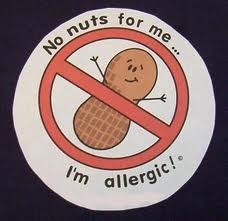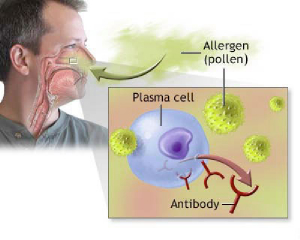Introduction
This article is about “peanut allergies are deadly”. In the US 1.5 million suffer from peanut allergies (Ref.1). People who have peanut allergies have to avoid peanuts and foods that contain even traces of peanuts lifelong. Here is a recent example of a 13-year old girl who died at a camp when she tried food contaminated with peanuts. Before we discuss peanut allergies in detail, we need to review first how the immune system is functioning.
How the immune system is primed to develop an allergy
Our immune system knows the difference between our own body components and substances that come from the outside. Scientists call this tolerance to our own surface proteins; and scientists call it an immune reaction that is mounting as a reaction to anything different from the surface antigens. There are different cells that make up the immune system. One of the main working cells of the immune system are the lymphocytes. A subtype are B cells that originate from the bone marrow producing antibodies when an immune reaction occurs. Antibodies fit like a lock and key to the surface of an antigen, in this case the peanut protein. T helper cells are T lymphocytes (thymus derived lymphocytes). They help the B cells to recognize the difference between the own protein components and the outside components.
IgE antibodies directed against peanut protein
There are also T killer cells, which when parasites or viruses enter the body activate them. With regard to peanut allergies, it is the B cells and T helper cells that interact. The B cells produce a powerful, very specific IgE antibody directed against peanut protein. There are memory B cells, which continue to produce these specific anti-peanut protein antibodies. They can cause severe allergic reactions when future exposure to peanuts (even traces) occurs. The more often a person allergic to peanuts encounters traces of peanuts, the more the immune system gets boosted. This produces even more antibodies of the IgE type through reactivated B memory cells (Ref. 2). 98% of the population does not react to peanut exposure with allergies. But the other 2% who may have genetic susceptibility factors that predispose them to this often develop life-threatening reactions. These have the name “anaphylactic reaction”.
What is an anaphylactic reaction to peanuts?
The most extreme form of allergies involving IgE antibodies can cause anaphylaxis. In the beginning stages of a peanut allergy there may only mild symptoms such as hives on the skin, itching and tingling around the mouth, a runny nose, a scratchy throat, wheezing, stomach cramps, vomiting or diarrhea. However, with a more severe allergy an asthma attack can develop. In this case the blood pressure drops leading to fainting or shock. In addition, severe airway obstruction in the throat or lungs can cause suffocation.
I vividly remember an 11-year-old boy who arrived by ambulance in the emergency room of the hospital where I was working as the on-call physician. He had a hard time talking as his throat was swelling up as part of his anaphylactic reaction, within minutes he passed out completely (shock). Fortunately, an anesthetist was in the department and could intubate him very quickly.
Period of unconsciousness
However, despite adrenaline treatment, oxygen by artificial ventilation and high doses of corticosteroid drugs he did not wake up until 10 hours later. In retrospect it turned out that he had eaten some crackers of a familiar brand that he knew as being free of peanut flour. However, he saw an ad that the same brand of crackers was available as cheese crackers and he tried one of these. This prompted his admission to the hospital. The parents read the ingredients later: the label on the cheese crackers noted in small print that the flour of the cheese crackers contained peanut flour! Always read labels, even if it is a familiar brand! Fortunately for this boy he did not have brain damage from the time of his unconsciousness. He has been extremely careful since and is reading labels and avoiding unknown food items.
Cross-reactions between peanuts and other allergens
Allergies can be made worse when a person has inhalant allergies from pollens of trees or grasses that can share protein components from protein found in foods. The latest findings are that there are cross allergies between Fenugreek and lupine, which are both legumes, as are peanuts, so there are common antigens present in their proteins. A mouse-testing model has shed more light on this. Fenugreek has been shown to control mild diabetes by improving insulin resistance, but it cannot be consumed by persons who are highly allergic to peanuts because of the cross allergy mentioned.
There are other possible cross allergies to legumes like lentils, soy and chickpeas.
Other factors that can cause allergies to get worse
In the past the RAST test was often used. This is a blood test for common food allergies that can cause severe allergic reactions like egg, milk, peanut, tree nuts, wheat, crustacean shellfish and soy. However, since about 2010 this has been replaced by the more sensitive ImmunoCAP Specific IgE test. Children who have food allergies to egg, milk, wheat, nuts, peanuts and soy often outgrow these allergies when they age, in other words their immune system can develop tolerance to many of these foods. Not so with peanut allergies! They tend to be very persistent.
Immune responses to food allergies are complicated
There are complications with immune responses to food allergies. They contained immediate type immune reactions and delayed type immune reactions. Allergists investigate the immediate immune responses with the above mentioned ImmunoCAP Specific IgE test. They can measure the delayed immune responses using the ELISA test. Positive IgE antibody tests for peanut protein are a marker that the person likely has more other allergies. An allergist should investigate them in that regard (Ref. 2).
New wheat varieties complicate the lives of people with allergies
What complicates the allergy sufferers’ lives even more is the fact that new wheat varieties were introduced. This happened in the 1970’s. The new wheat has the name Clearfield wheat. It has a much higher gliadin (gluten) and lectin content than the old wheat varieties. As a result of exposure to this new type of wheat gluten intolerance and leaky gut syndrome have increased substantially in the world population (Ref.3). In addition, genetically modified foods like soy, corn, sugar beets, canola and others have challenged the immune system of sensitive humans even more.
Autoimmune diseases from GMO food and modern wheat
We do know that some people can develop autoimmune diseases from GMO foods and modern wheat, and this may be the reason that a host of diseases that belong into this disease category (MS, rheumatoid arthritis, Hashimoto’s thyroiditis, ankylosing spondylitis etc.) are much more common now than in the past. The geneticists developing GMO foods were unaware how sensitive the immune system is. The immune system detects a few different amino acid sequences in a protein mounting a strong immune response to it.
Treatment for peanut allergies
The key for sufferers from peanut allergies is to avoid exposure to it. Read labels and use common sense. If a food item has no label, do not attempt to eat it. Food manufacturers often mix peanut flour into the dough of crackers. But not every product has a label that identifies whether peanut flour is in it. Alternatively it says so only in fine print. With peanuts the antibodies usually circulate in the blood life long. The reason is that the B memory cells do not diminish and experience reactivation very quickly on repeat exposure. At this time they produce antibodies again. As exposure to peanuts can cause severe asthma or anaphylactic shock, it is important to carry an EpiPen with you and to know how to use it.
Oral immunotherapy
In Europe attempts have been made to develop an oral desensitization method for food allergies including peanut allergies, but it has not produced concrete results yet. Recently, however, research from Texas, USA showed that it is possible to desensitize patients with peanut allergy by oral desensitization. In Australia where food allergies are more prevalent than in the US, tolerance to peanut, nut and shellfish allergies is being pursued by oral immunotherapy. Another group in Australia has developed a vaccination method using peptides, which are a sequence of amino acids, but shorter than the full peanut protein. It appears that this is the future direction of treatment for peanut and other IgE allergies: a kind of vaccination treatment to induce competing antibodies, which will neutralize the allergic IgE antibodies.
Conclusion
Peanut allergies have become more troublesome as the food industry has mixed peanut flour into Thai sauces, drinks, cookies, crackers and such. The person allergic to peanuts must read food labels and eat as much single-ingredient natural food as possible. This goes against the tendency of food processors who produce foods with a long rat tale of ingredients. If you see a label “may contain nuts or peanuts”, stay away from this product, as it is safer. Always carry an EpiPen or Twinject with you, just in case you develop an anaphylactic reaction (you only have a few minutes to stop the allergic reaction with adrenaline). In the future vaccination with a peanut protein specific peptide vaccine as mentioned regarding the Australian research, will probably become the treatment of choice.
More information on status asthmaticus (an acute asthma attack).
References
1. Adkinson: Middleton’s Allergy: Principles and Practice, 7th ed. Chapter: Food Allergy. © 2008 Mosby.
2. Mandell: Mandell, Douglas, and Bennett’s Principles and Practice of Infectious Diseases, 7th ed.© 2009 Churchill Livingstone.
3. William Davis, MD: “Wheat Belly Cookbook. 150 Recipes to Help You Lose the Wheat, Lose the Weight, and Find Your Path Back to Health”. HarperCollins Publishers LTD., Toronto, Canada, 2012.








